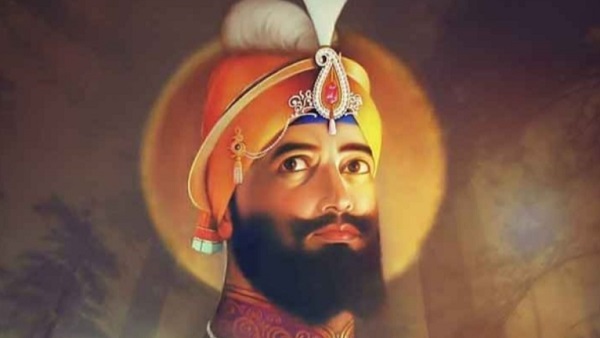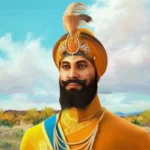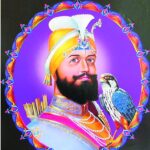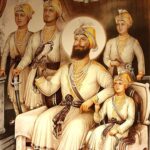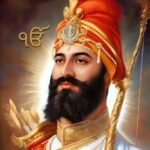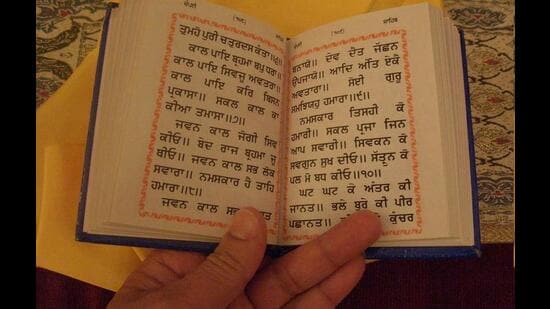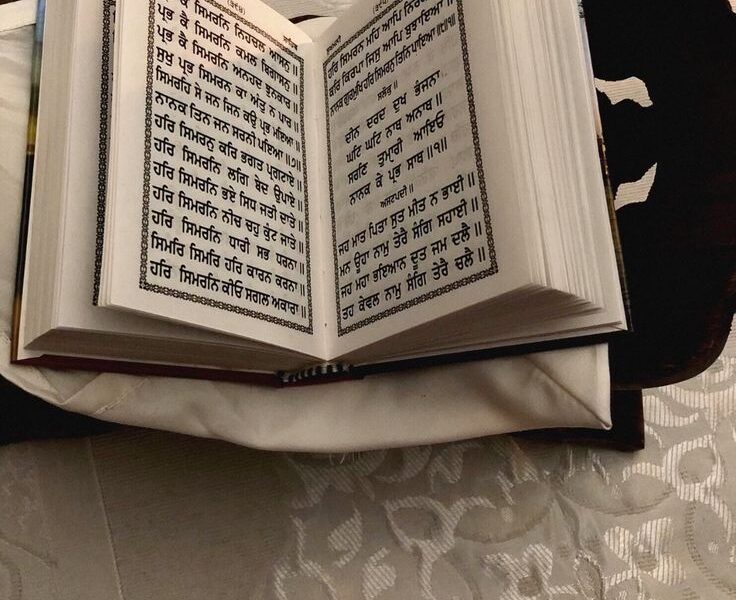Birth of Guru Gobind Singh Ji (1666)
[For Punjabi Version Click Here]
The Prakash Gurpurab of Sri Guru Gobind Singh Ji holds immense significance in the Sikh calendar, commemorating the birth anniversary of the tenth Guru. Observed on the 7th day of the month of Magh in the Nanakshahi calendar, the occasion is celebrated with great enthusiasm by Sikhs worldwide. Guru Gobind Singh Ji was born on December 22, 1666, in Patna, Bihar, India, according to the Gregorian calendar.
The term “Prakash Gurpurab” is deeply symbolic, signifying the illumination or enlightenment associated with the birth of a Guru. It represents the divine light that a Guru brings into the world, dispelling darkness and ignorance. Guru Gobind Singh Ji, being the embodiment of spiritual wisdom, fearlessness, and righteousness, is revered by Sikhs as a guiding light in their lives. The celebration of Guru Gobind Singh Ji’s Gurpurab is a joyous occasion filled with spiritual fervor and cultural activities. Sikhs engage in various religious practices and community events to honor the teachings and legacy of their revered Guru. Guru Gobind Singh Ji played a pivotal role in shaping the Sikh identity and reinforcing the principles laid down by the earlier Gurus. His Gurpurab is an opportunity for Sikhs to reflect on his life, teachings, and the sacrifices he made for the sake of righteousness and justice. The day typically begins with the Nagar Kirtan, a grand procession involving the Sikh community singing hymns and carrying the Guru Granth Sahib, the holy scripture, in a procession throughout the city. This public display of devotion and unity marks the beginning of the celebrations.
Another significant aspect of the Gurpurab is the organization of Akhand Path, a continuous reading of the Guru Granth Sahib that usually takes 48 hours to complete. This continuous recitation is a spiritual practice that involves individuals taking turns reading the sacred text, fostering a sense of community and devotion. Gurdwaras, Sikh places of worship, are beautifully decorated to commemorate the occasion.
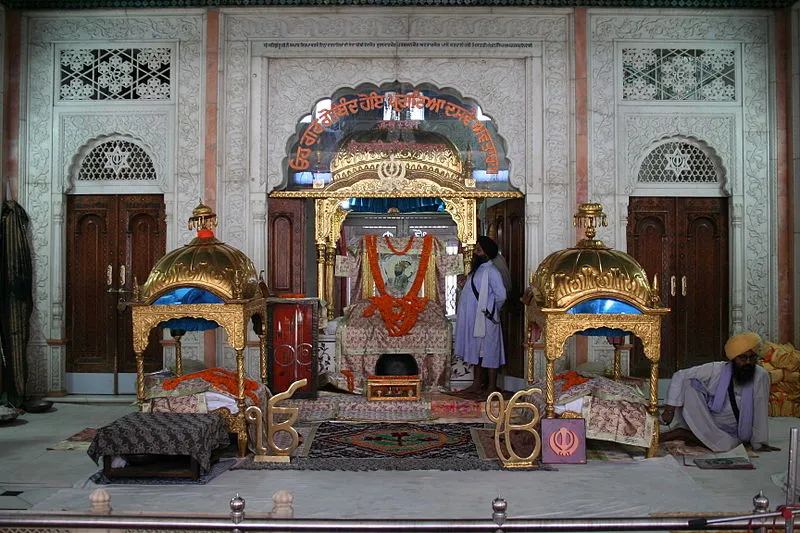
Sikhs attend special prayers and hymn recitations, deepening their connection with the Guru’s teachings. The celebration extends to homes, where families come together to share meals and engage in acts of seva (selfless service) as a way of giving back to the community. Guru Gobind Singh Ji’s Gurpurab is a time of spiritual reflection, community bonding, and a reaffirmation of the values that define Sikhism. It serves as a reminder to Sikhs of the divine light that Guru Gobind Singh Ji brought into the world, inspiring them to walk the path of righteousness and equality in their lives.
Guru Gobind Singh Ji’s Gurpurab is a special occasion for Sikhs. Every year Sikhs all over the world celebrate this important day with great enthusiasm. Guru Gobind Singh Ji was the tenth Guru of the Sikhs (1666-1708) and this Gurpurab is a celebration of when Guru Gobind Singh Ji came into the world.
Early Life and Education
Guru Gobind Singh Ji, the tenth Sikh Guru, grew up in Anandpur Sahib, a city his father, Guru Tegh Bahadur Ji, had built. In his early years, Guru Gobind Singh Ji learned many things that shaped him into an exceptional leader. Guru Gobind Singh Ji studied various subjects like languages (Sanskrit, Persian, and Gurmukhi) and different branches of knowledge, including history and literature. This made him knowledgeable about the culture and traditions of that time. Guru Tegh Bahadur Ji, recognizing Guru Gobind Singh Ji’s spiritual potential, guided him spiritually. Anandpur Sahib was a spiritual center, and here Guru Gobind Singh Ji learned about Sikh Gurus’ teachings and Sikh philosophy.
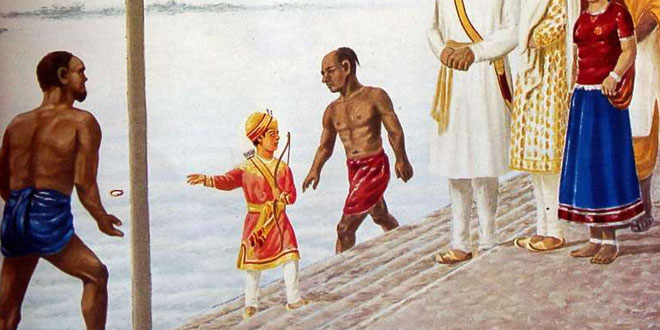
Guru Gobind Singh Ji’s early experiences influenced his decision to create the Khalsa Panth. He wanted Sikhs to have a distinct identity, and this vision came from the situations he observed during his formative years. Guru Gobind Singh Ji learned many things as a child – from books and martial arts to spirituality. He showed remarkable qualities and used his experiences to shape the Sikh community’s future, eventually establishing the Khalsa.
Guru Gobind Rai Becomes Guru Gobind Singh Ji (1675)
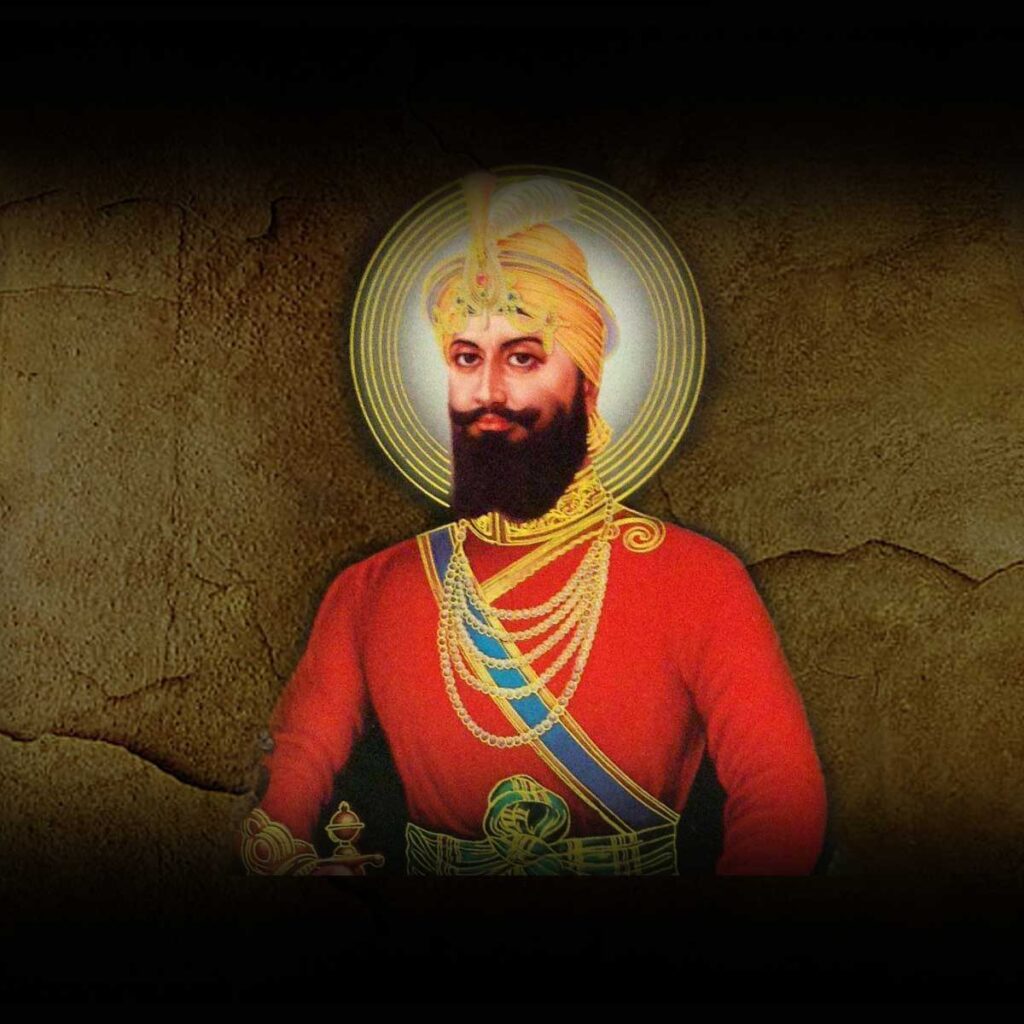
After the death of his father, Guru Tegh Bahadur Ji, young Guru Gobind Rai took on the role of the Guru at only nine years old. This meant he became Guru Gobind Singh Ji, the spiritual leader of the Sikhs. Despite his young age, he shouldered the responsibilities that came with guiding and leading the Sikh community.
Establishment of the Khalsa (1699)
One of the major events linked to Guru Gobind Singh Ji is the formation of the Khalsa, a community of baptized Sikhs. On Vaisakhi day in 1699, Guru Gobind Singh Ji initiated the first five beloved ones, known as the Panj Pyare. Subsequently, he himself received initiation from them. This event marked the establishment of the Khalsa and included the Amrit Sanchar, a baptism ceremony.
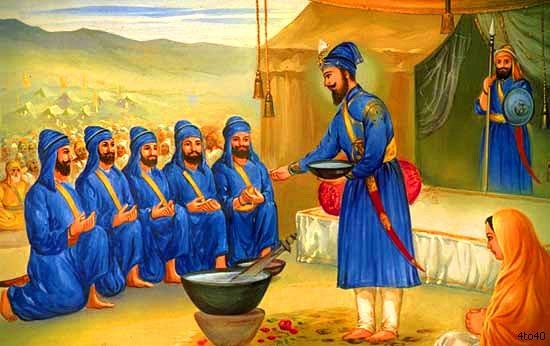
Vision for the Khalsa
Guru Gobind Singh Ji’s experiences and observations during his early years played a crucial role in shaping his vision for the Khalsa. The challenges posed by the political and social landscape of the time influenced his decision to establish a distinct identity for Sikhs through the creation of the Khalsa Panth. Guru Gobind Singh Ji’s upbringing in Anandpur Sahib laid the foundation for his later role as the spiritual and temporal leader of the Sikh community. His education, martial training, and spiritual guidance were integral to his ability to guide the Sikhs through turbulent times, and his legacy continues to inspire millions of people worldwide.
Martyrdom of Guru Gobind Singh Ji (1708)
Guru Gobind Singh Ji encountered numerous challenges and hardships, including the tragic loss of his family members. He departed from this world in 1708, leaving behind a legacy of a sovereign Sikh identity and a community devoted to justice and equality. The Prakash Gurpurab of Sri Guru Gobind Singh Ji is celebrated with immense enthusiasm and respect by Sikhs worldwide. It serves as a time for contemplation on the Guru’s teachings, fostering unity within the Sikh community, and engaging in selfless service. The events and principles linked to Guru Gobind Singh Ji’s life continue to be a profound source of inspiration for Sikhs during this auspicious occasion.
Inspirational Teachings of Guru Gobind Singh Ji
Equality
Guru Gobind Singh Ji strongly emphasized the concept of equality. Regardless of one’s caste, creed, or gender, everyone was considered equal in the eyes of the Guru. To promote this idea, Guru Gobind Singh Ji initiated the Khalsa, a community of baptized Sikhs who embraced the values of equality and justice.

Defense of Dharma
Guru Gobind Singh Ji was a staunch advocate for standing against tyranny and injustice. He encouraged Sikhs to defend righteousness and protect the oppressed. The Guru believed in the principle of dharma, which involves upholding moral and ethical values. Sikhs were inspired to confront injustice and uphold the principles of truth and justice. These teachings aimed to create a society where every individual, regardless of their background, was treated with dignity and respect. The initiation of the Khalsa was a transformative step in promoting equality and instilling a sense of justice and righteousness within the Sikh community.
Celebration
Nagar Kirtan
Nagar Kirtan is a vibrant and joyous procession that marks the commencement of the celebration. It involves the Sikh community coming together to sing hymns, known as kirtan, and carry the Guru Granth Sahib in a procession through the streets of the city or town. The Nagar Kirtan is a public display of Sikh devotion and a means of sharing the teachings of Guru Gobind Singh Ji with the broader community. It promotes unity, peace, and the spirit of sharing Sikh values.
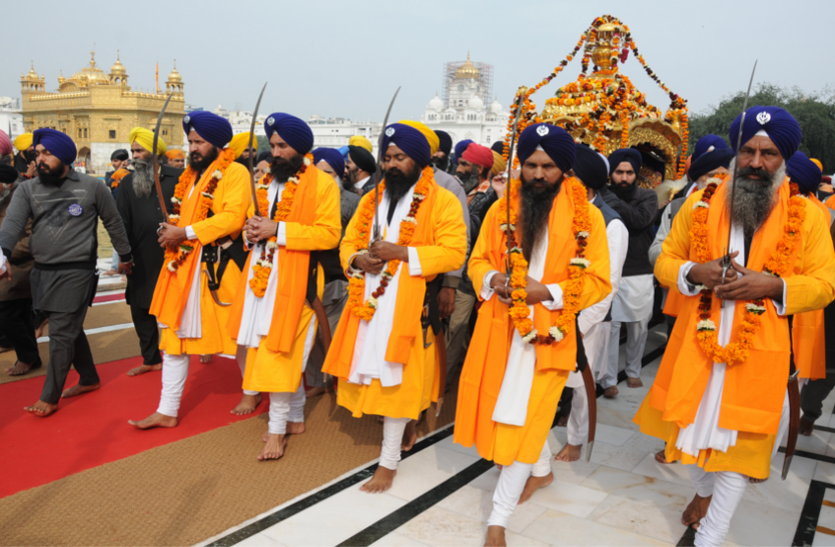
Akhand Path
Akhand Path is a continuous, uninterrupted reading of the Guru Granth Sahib, the central religious scripture of Sikhism. This reading typically takes 48 hours to complete, involving a relay of readers. Akhand Path is considered a deeply spiritual and communal activity. It allows Sikhs to engage in the sacred words of the Guru, seeking inspiration, guidance, and blessings. Devotees often contribute to the reading by taking turns.
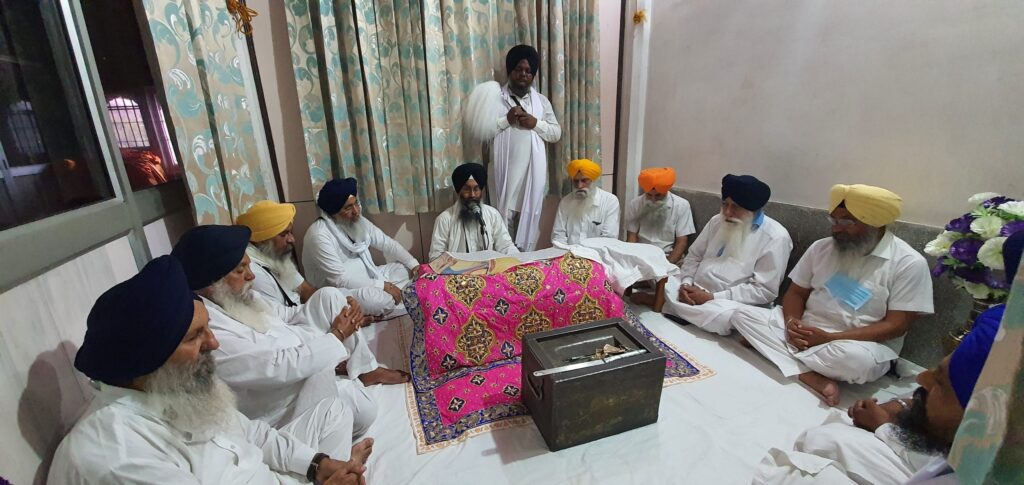
Gurdwara Decorations
Gurdwaras, Sikh places of worship, are adorned and decorated with great care and creativity to commemorate the auspicious occasion of Prakash Gurpurab. The decorations often include vibrant flowers, lights, and artistic displays. The intention is to create a joyous and sacred atmosphere within the Gurdwara, reflecting the celebratory spirit of the occasion.Community Participation: Members of the Sikh community actively participate in the beautification of the Gurdwara. It is common for volunteers to come together to contribute their time and effort for the decorations.
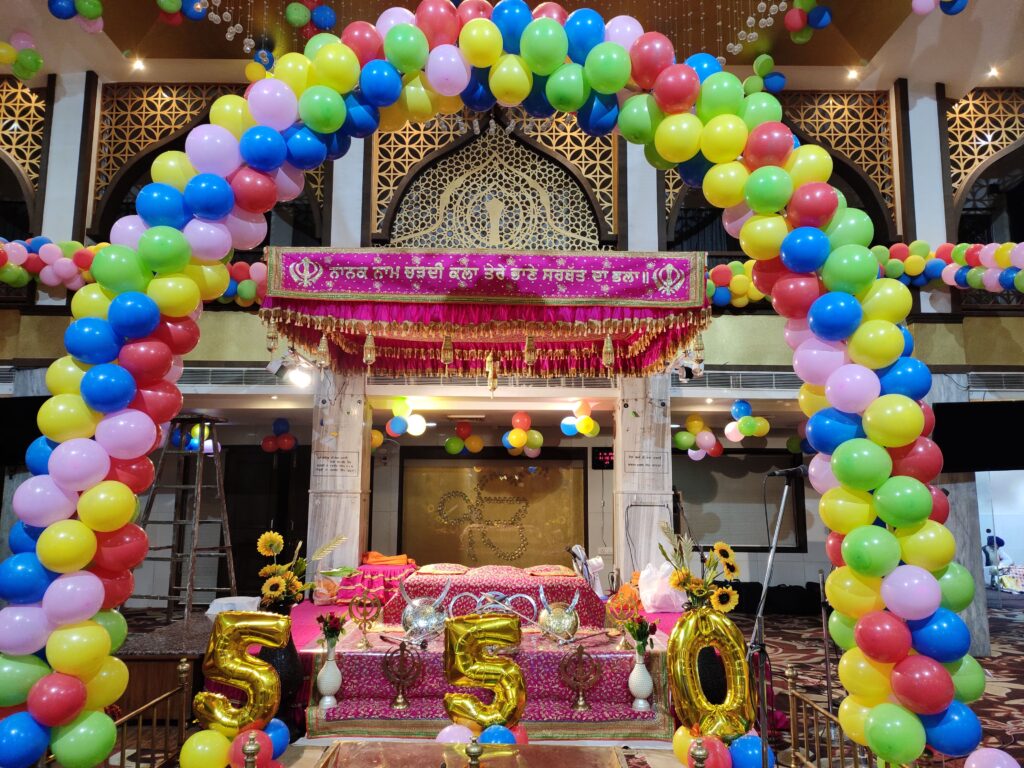
Special Prayers and Hymn Recitations
Special prayer sessions and hymn recitations are organized within Gurdwaras during Prakash Gurpurab. These sessions may include hymns and verses from the Guru Granth Sahib that highlight the life, teachings, and contributions of Guru Gobind Singh Ji. Devotees gather to listen to these recitations, seeking spiritual enlightenment.
Community Service and Langar
Prakash Gurpurab is also an occasion for community service and selfless giving. Langar, a community kitchen, serves free meals to all visitors, irrespective of their background.Langar embodies the Sikh principle of equality and selfless service. It reflects Guru Gobind Singh Ji’s teachings on compassion and community support. Prakash Gurpurab is a multifaceted celebration that combines spiritual, communal, and service-oriented activities. The festivities not only involve religious rituals but also emphasize the Sikh values of community, equality, and selfless service.
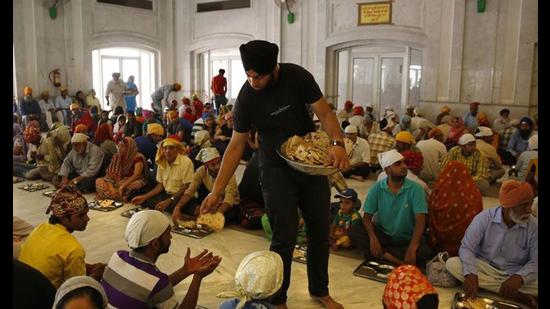
Moral life of Sri Guru Gobind Singh Ji
Courage and Fearlessness
Guru Gobind Singh Ji exemplified unparalleled courage and fearlessness in the face of adversity. His unwavering commitment to righteousness and justice, even in the most challenging circumstances, serves as a moral beacon for followers to stand up against tyranny and oppression with courage.
Equality and Social Justice
Guru Gobind Singh Ji started the Khalsa, a community of baptized Sikhs, to promote equality and justice. He got rid of distinctions based on caste and creed, saying that everyone, no matter their background, is equal in the eyes of the Divine. This lesson encourages his followers to support social justice and equality in society.
Sacrifice and Selflessness
Guru Gobind Singh Ji’s life was full of big personal sacrifices, including the heartbreaking sacrifice of his family members. His willingness to give up his own life for what is right and for protecting those who couldn’t protect themselves teaches the moral values of sacrifice and selflessness for the greater good.
Defense of Dharma
Guru Gobind Singh Ji strongly stood against injustice and tyranny, stressing the moral duty to defend dharma, which means righteousness. Sikhs are encouraged to resist oppression, uphold moral values, and protect those who are unable to protect themselves.
Spiritual Discipline and Devotion
Guru Gobind Singh Ji highlighted the importance of spiritual discipline and devotion to the Divine. Following a daily routine of prayers, meditation, and sticking to the Sikh code of conduct (Rehat Maryada) are moral necessities for followers, encouraging a life of piety and spiritual connection.
Empowerment and Self-Reliance
Guru Gobind Singh Ji empowered the Sikh community by creating the Khalsa and giving them the identity of the “Saint-Soldier.” This moral lesson promotes self-reliance, empowerment, and the responsibility to stand up for one’s beliefs and protect those who are vulnerable.
Tolerance and Interfaith Harmony
Despite facing persecution, Guru Gobind Singh Ji spoke up for religious tolerance and harmony. His moral teachings stress respecting the diversity of faiths and building understanding among different communities.
Service to Humanity
The idea of seva, or selfless service, is a fundamental moral principle in Sikhism, reinforced by Guru Gobind Singh Ji. Followers are urged to perform acts of kindness, charity, and service to humanity, embodying the spirit of compassion and altruism. The life of Sri Guru Gobind Singh Ji weaves a beautiful tapestry of moral values, encouraging Sikhs to live with bravery, compassion, and a strong sense of justice in their everyday lives. His teachings continue to lead and inspire individuals on their spiritual and ethical journeys.
Aurangzeb, the fifth Mughal emperor, was known for his strict adherence to orthodox Islamic practices and policies. He imposed heavy taxes on non-Muslims and attempted to enforce strict Islamic laws. Guru Gobind Singh Ji, on the other hand, was a proponent of religious freedom and the protection of all individuals’ rights to practice their faith.
Encounter with Aurangzeb
As the story goes, Aurangzeb invited Guru Gobind Singh Ji to meet him in person. During their meeting, Aurangzeb attempted to persuade Guru Gobind Singh Ji to embrace Islam. The emperor believed that converting the influential Guru would serve as a powerful symbol and encourage others to follow suit.
Guru Gobind Singh Ji’s Response
In response to Aurangzeb’s request, Guru Gobind Singh Ji is said to have responded with great poise and courage. The Guru expressed his commitment to upholding the principles of his faith and maintaining the Sikh way of life. He respectfully declined Aurangzeb’s offer to convert to Islam.
The Beheading Challenge
Aurangzeb, frustrated by Guru Gobind Singh Ji’s refusal, issued a challenge. He proposed that if the Guru truly had divine protection, he should behead him and witness his immediate resurrection. Guru Gobind Singh Ji accepted the challenge, and with a single stroke, he struck down a goat, demonstrating his faith in the Almighty.
Message of Tolerance
Guru Gobind Singh Ji’s refusal to convert and his acceptance of the beheading challenge conveyed a powerful message of religious tolerance and the right of individuals to practice their faith freely. The Guru’s commitment to the principles of Sikhism, even in the face of potential harm, became a source of inspiration for his followers.
Personal Details
Guru Gobind Singh Original Name: Gobind Rāi
Guru Gobind Singh Date of Birth: December 22, 1666
Death Date: October 7, 1708
Place of Death: Hazur Sahib, Nanded, India
Age(at the Time of Death): 42
